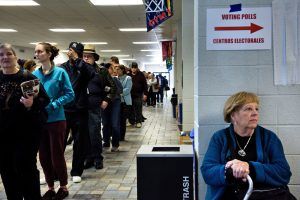Lee Drutman in the New York Times:
 In the months leading up to Monday’s Supreme Court punt on the gerrymandering cases out of Wisconsin and Maryland, those hoping the court would rein in partisan gerrymanders had been cautiously optimistic. Justice Anthony Kennedy made it known that if a “workable standard” could be found to distinguish legitimate districting from partisan gerrymandering, he might sign onto it. Reformers thought they had found that standard in something called the “efficiency gap.”
In the months leading up to Monday’s Supreme Court punt on the gerrymandering cases out of Wisconsin and Maryland, those hoping the court would rein in partisan gerrymanders had been cautiously optimistic. Justice Anthony Kennedy made it known that if a “workable standard” could be found to distinguish legitimate districting from partisan gerrymandering, he might sign onto it. Reformers thought they had found that standard in something called the “efficiency gap.”
But for now, with the court’s decision to not rule on the central questions the cases raise, we still lack a standard. The light is still green for state legislatures to draw maps as they please, and tempt their luck in the lower courts.
There is a deep unfairness here that increasingly undermines democratic legitimacy. Aggressive Republican gerrymandering after the 2010 census helped the party to win a majority of House seats in 2012 even though it got fewer votes across all congressional districts. There is a very real possibility of a repeat “plurality reversal” in 2018, with Democrats again getting more votes but not gaining control of the House. Today’s congressional map is more biased in favor of Republicans than it has been in over 100 years, in good part because of gerrymandering. (Geography also plays an important role: Democrats simply waste a lot of votes by concentrating in cities.)
Reformers could certainly try again next year, perhaps finding new approaches to avoid the shoals of standing. But a better approach would be to revamp the antiquated electoral institution that makes elaborate districting schemes both possible and so profitable in the first place — the single-member district. Increase the size of districts (and use ranked-choice voting to improve proportionality) and the predictability of results declines, making gerrymandering far less effective.
More here.
